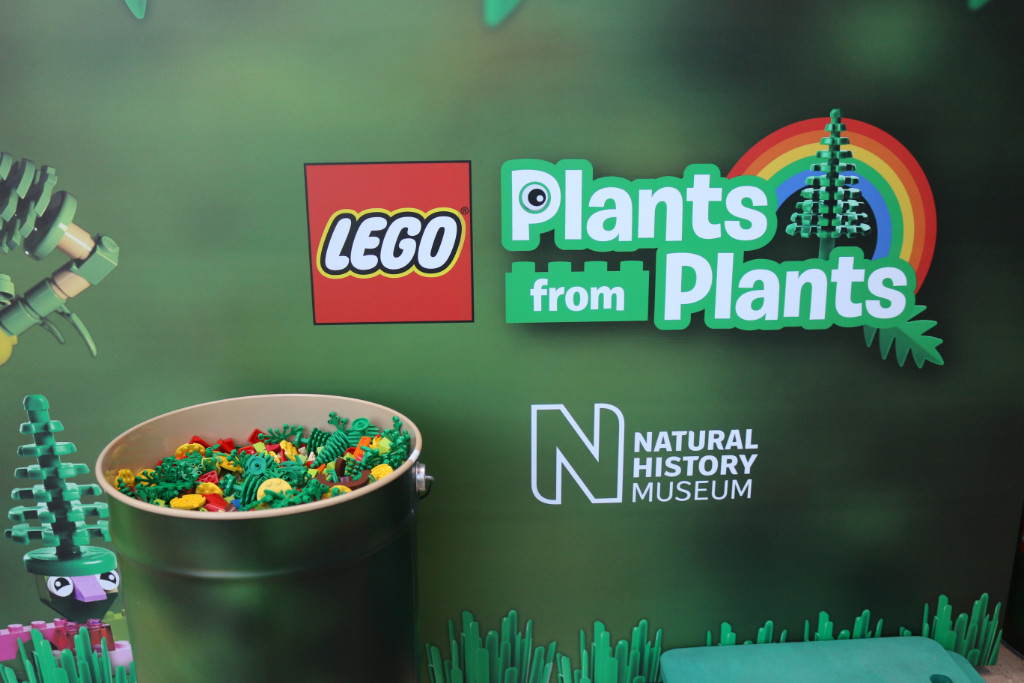Introducing sustainable LEGO elements: Plants from plants and beyond
The LEGO Group reveals the company’s ambitious new plan to use sustainable materials to manufacture all elements by 2030 – including the beloved 2×4 brick
Earlier this year, the LEGO Group caused something of a stir when the company announced its intention to only using sustainable materials by 2030. Sure, rumblings had been made before about such a scheme, but a fixed date had never been put in place – it always seemed a laudable aspiration rather than a firm commitment. At the LEGO Fan Media Days, the team behind the sustainable pieces had the perfect opportunity to explain more about the changes to brick aficionados around the world.
It is Matthew Whitby, Environmental Responsibility Engagement (ERE) Manager and Bistra Andersen, Senior Material Platform Manager who arrive at the LEGO Ideas House on a sunny summer Wednesday to present a scheme that the company is keen to spread awareness of.
The duo are here to demonstrate what the LEGO Group is doing to move towards using sustainable materials across the entire product portfolio, beginning with the botanical elements that are being introduced this year. This project has a name – 2030 Sustainable Materials Challenge – and aims to move away from materials such as ABS and find sustainably sourced replacements.
A target of 2030 has been put in place for the LEGO Group to have all materials in products either be plant based, or manufactured from recycled materials. “It’s quite difficult to change all of the elements that we’ve been producing for 60 years,” says Matthew, in what is quite the understatement. Indeed, it surprised many when the 2030 target was announced – a mere 12 years away, it is clearly an ambitious goal.
“Our ambition is by 2030 is to identify and to develop together with partners sustainable materials that would be either plant based, so coming from a renewable resource, or recycled materials,” Bistra explains. Her team has been working on the project for five years already, and the LEGO Group has a fixed definition of a sustainable material: “the material that meets our high quality and safety standards and at the same time has key environment and social sustainability attributes.”
The key message that both Bistra and Matthew keep coming back to is that quality will not be comprised. No matter what material the elements are made from, the pair guarantee that consumers will find no difference between the new sustainable pieces and those that fans are used to.
When the question of biodegradability comes up, Matthew is quick to quash the notion that the new pieces will be compostable. “It’s definitely not supposed to be biodegradable. We’re still going to make plastic, we’re still going to make high quality plastic. Everything’s going to have a long life time.
“Most people do not throw away the LEGO bricks, at least we certainly hope not. Occasionally you do see the story about a ship that has lost a container in the middle of the Atlantic and pieces are washing up on a beach in England. We don’t like to see that, but of course, that’s out of our control.”
Despite that focus on quality, the goal being presented is to improve the environmental impact that the LEGO Group has, with the private ownership cited as helpful in being able to push through such initiatives. “It is quite a challenge to establish materials which both meet the technical requirements and also these sustainable attributes,” Bistra acknowledges.
To live up to these “key environmental and social sustainability attributes”, the materials used must be sustainably sourced, with minimum waste across the supply chain – from when the materials are produced right through to when a box of LEGO bricks lands on a toy shop shelf.
It is acknowledged that it is not possible to manufacture such a product in a way that has no environmental impact whatsoever. “If you’re pulling oil out of the ground, or if you’re cutting down trees, it’s having an impact. The benefit is that we can replace the trees a lot faster than we can replace the oil, that’s for sure,” Matthew says.
“What we want to do is make sure that that we can build up this material together with our suppliers to make sure that we have a certain amount of control on the process,” he continues. The LEGO Group is researching the polymers that can be used to produce bricks, but with large parts of the process contracted to external partners, a lot of co-ordination must be done from Billund.
Bistra confirms that the company has collaborated with external partners and sought a great deal of advice. The LEGO Group will monitor which chemicals are used in the supply chain, with everything documented so that the environmental impact can be assessed.
That is not all that is being taken into account, as toys must also live up to exacting safety standards to avoid harming children. When it comes to introducing new substances, they all have to be checked against existing toy legislation, with relevant documentation produced. As well as the LEGO Group testing internally, external agencies are used to confirm that materials and chemicals are safe.
One of the challenges that the LEGO Group faces is that the company uses a very specific type of ABS in the bricks, unique within the toy industry. There are few other manufacturers who the construction toy giant can collaborate with, meaning that all of the resources going into this project to find a replacement are coming from the LEGO Group. In order to avoid shortages and achieve consistency, a material that multiple suppliers can produce is necessary. “We are responsible for the selection of all plastic materials that are used in our products,” says Bistra.
To demonstrate the progress that has been made so far, Matthew and Bistra reveal a batch of 2×4 LEGO bricks for the assembled media to handle and get a sense of. “This prototype is a polymer that is based on corn and this material has at least 50% biocontent,” Bistra explains, passing the piece around. “It looks and feels like a brick, but we are still in the process of deeply testing this material and understanding it. Is it really a solid solution? Could it be implemented on a large scale in the coming years?”
As well as regular bricks, there are transparent bricks to inspect, which present a unique set of obstacles. “Some of you already started touching them and complaining that they have too high friction. So this material is made of wood pulp from FSC (Forest Stewardship Council) certified forests. The bricks are solid and stick, yet the friction is too high.
“The technical challenge with this material is to fine tune the friction and at the same time introduce the needed strength. If you try to perform a drop test on such a brick, the bricks will typically break in a brittle manner. So together with our partners we are trying to identify a solution, where we want to improve the impact properties of the polymer of the plastic and avoid any future product safety issues.”
With these basic bricks still quite a distance from perfection, the sustainability experts reveal elements that are already in production – these have been through the research process, the prototyping phase and are now being churned out by LEGO factories. These are the botanical elements, including the classic conifer trees.
“We are so happy that our first plant based plastics are plants,” the ERE Manager enthuses. “There are about 150 types of elements we can now start producing from plant based plastic. This is made from sugarcane, coming from a supplier in Brazil, and we are making sure that we work with WWF (World Wildlife Fund) to ensure that this sugarcane is sourced sustainably. We are not displacing any people from the land or using the land that could have been used to make food stocks.”
The focus is on plants elements because these provide a nice marketing hook, but a few other elements made from softer, non-ABS plastic are also provided for Brick Fanatics to take a look at. Sure enough, holding the previous and new versions of the pieces side by side, there are no differences to note.
To introduce the new elements to consumers, the LEGO Group has developed 40320 Plants from Plants. This special little box only contains the new plant based botanical elements and is set to be given away in a promotion launching at [geot exclude_country=”United States”]shop.LEGO.com[/geot][geot country=”United States”]shop.LEGO.com[/geot] on August 1. In the rest of the range, the new elements will simply be rotated in as existing stocks run out, so this is a unique opportunity for fans to get hold of a box containing only the new plant based elements.
So the message from the LEGO Group is that sustainable elements are on the way – 2×4 bricks will be made from renewable or recycled materials by 2030. There is a way to go yet to achieve that, but with these botanical elements representing the first green shoots of success, fans will be watching attentively to see what grows and eventually blossoms from here.
The Plants from Plants promotion will launch on August 1 at [geot exclude_country=”United States”]shop.LEGO.com[/geot][geot country=”United States”]shop.LEGO.com[/geot].
Author Profile
- Graham was the Brick Fanatics Editor up until November 2020. He has plenty of experience working on LEGO related projects, including LEGO Star Wars: The Force of Creativity. He has contributed to various websites and publications on topics including niche hobbies, the toy industry and education.
Latest entries
25 Years of LEGO Star Wars06/05/2024How LEGO has spent the past 25 years making the Millennium Falcon better – and bigger
25 Years of LEGO Star Wars02/05/2024How Lucasfilm approved LEGO Star Wars sets in the age before video calls
25 Years of LEGO Star Wars01/05/2024How the LEGO Group cooked up the original LEGO Star Wars UCS X-wing
Features07/01/2021LEGO exclusive: AFOLs taught us to take adults seriously







